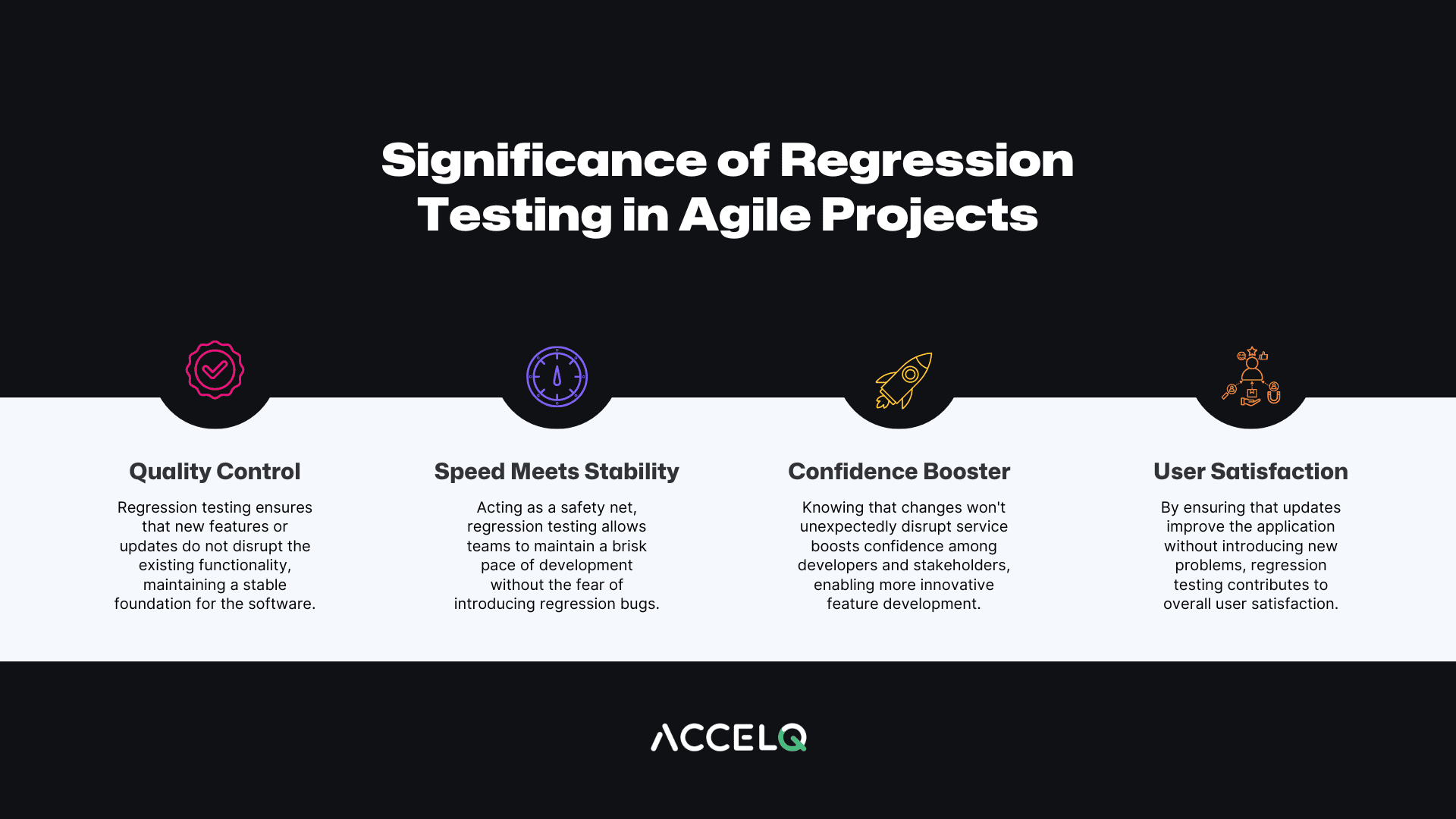What Is Regression Testing In Agile?

Where change is the only constant in software development, agile techniques provide flexibility and speed. However, with numerous iterations and regular changes, it is difficult to maintain a fluid workflow.
Regression testing in the agile process monitors the software and ensures that each line of code improves the application without interfering with current features. It strikes a delicate balance between new updates and existing apps.
- Significance of Regression Testing in Agile Projects
- What is right team for Agile Regression Testing?
- When to Conduct Regression Testing?
- How much test coverage is required?
- Balancing Manual and Automated Testing
- Developing an Agile Regression Testing Strategy
- Overcoming Common Challenges
- Conclusion
Significance of Regression Testing in Agile Projects
Why bother with regression testing in Agile? Well, it's all about keeping the software's quality top-notch without slowing down the pace. Agile thrives on speed and adaptability, but this speed can lead to errors slipping through the cracks without regression testing.

Quality Control:
As new features or updates are introduced, regression testing acts as a critical checkpoint, ensuring these additions do not disrupt the existing functionality. It's about maintaining a stable and reliable foundation upon which the software continues to build and evolve.
Speed Meets Stability:
With the constant release of new features, it's easy to trip over existing functionality. Regression testing is the safety net that catches these potential falls, allowing teams to maintain a brisk pace without fear of regression bugs.
Confidence Booster:
Knowing that changes won't unexpectedly disrupt service is invaluable for developers and stakeholders. This confidence enables more innovative and bold feature development, pushing the software to new heights.
User Satisfaction:
Regression testing ensures that updates improve the application without introducing new problems.
SUGGESTED READ - What is Regression Testing?
What is right team for Agile Regression Testing?
In the agile framework, the optimal configuration for regression testing involves a collaborative effort transcending traditional roles. Developers, testers, and QA specialists share the stage.
This collaborative approach guarantees everyone is on the same page, making testing easier and more efficient.
Developers, testers, and QA specialists collaborate, each bringing their expertise to the table, to ensure the product operates well after each update.
When to Conduct Regression Testing?
Deciding when to do regression testing in an agile setup is like finding the perfect time to water your plants. Too much or too little can lead to problems. The key is regularity. In agile, changes happen fast, so testing should be frequent to catch issues early.
Ideally, you would run regression tests after every significant change or at least at the end of every sprint. This ensures no new feature or bug fix has thrown a wrench into the works. It's about maintaining a healthy balance, ensuring the software grows stronger and more resilient with each change.
How much test coverage is required?
You want to bring enough to be prepared but not so much that you are weighed down. In agile development, aiming for 100% test coverage is like trying to pack your entire closet. It's not just impractical but also unnecessary.
Focus on the essentials that most users interact with, such as core features and functions. This approach ensures efficient resource use while maintaining a safety net for the software. It's about finding the right balance between being confident in the software's stability and testing every possible scenario.
Balancing Manual and Automated Testing
In regression testing, finding the correct balance between manual and automated testing is critical in agile contexts.
- Manual Testing provides a thorough, human-centered approach that is excellent for new features and difficult scenarios. It offers depth and insight that automation cannot.
- Automated testing provides speed, consistency, and efficiency, making it ideal for repetitive jobs and delivering timely responses within agile cycles.
The strategy combines the strengths of both methods. Automated testing speeds up the process, covering more terrain quickly. Manual testing provides a clear view of areas that automation may ignore. This combination ensures the software is resilient and adaptable, reacting efficiently to user needs and changing project requirements.
Developing an Agile Regression Testing Strategy
Crafting an agile regression testing strategy is like planning a road trip. You need a map (your test plan), regular pit stops (continuous integration), and a good co-pilot (your testing team).
| Step | Objective | Action |
|---|---|---|
| 1. Identify Core Features | Pinpoint the most critical functionalities that your users rely on. | Collaborate with stakeholders to list essential features that must always work flawlessly. |
| 2. Maximize Automation | Increase efficiency and coverage of regression tests. | Select repetitive and high-volume tests for automation, focusing on those core features. |
| 3. Integrate Early and Often | Ensure testing is a continuous part of development, not an afterthought. | Implement continuous integration (CI) to run regression tests for every code commit. |
| 4. Prioritize Test Cases | Manage testing efforts effectively, especially under tight deadlines. | Rank tests based on feature importance and bug risk to focus on high-impact areas first. |
| 5. Review and Refine | Keep your regression testing strategy aligned with the evolving product. | Regularly review test results, update new features, and retire tests for deprecated functionality. |
| 6. Foster Collaboration | Create a shared responsibility for quality across the team. | Encourage developers, testers, and stakeholders to work together to identify testing needs and interpret results. |
Overcoming Common Challenges
Challenges in regression testing are like hurdles in a race, they are inevitable, but with the right technique, you can clear them.
Challenge: Rapid Agile Cycles Outpace Testing
Solution: Use Continuous Integration (CI) and Continuous Deployment (CD) pipelines to automate regression testing.
Example: A software development team links its regression testing suite with a continuous integration and delivery pipeline, allowing tests to run automatically with each code commit. This ensures that testing keeps up with the quick development cycles and detects regressions in real time.
Challenge: Maintaining an Up-to-date Test Suite
Solution: Implement a test maintenance approach that involves regular reviews and updating of test cases to keep up with new features and modifications.
Example: At the conclusion of each sprint, the team reviews the regression test suite. Eliminates outdated tests and introduces new ones based on recent changes. This keeps the test suite current and efficient.
Challenge: Balancing Test Coverage with Test Execution Time
Solution: Prioritize test cases based on risk and usage patterns, emphasizing the application's highest-impact regions.
Example: Using analytics, the team finds the most frequently used features by their users and prioritizes them for regression testing. This strategy ensures that the most crucial functionalities are always evaluated first, maximizing coverage and efficiency.
Challenge: False Positives and Test Flakiness
Solution: Implement strong test design principles and use test automation tools to improve reliability and stability.
Example: To limit the number of false positives, the team uses a combination of data-driven testing and trustworthy automation technologies. They also have a "flaky test" quarantine mechanism, which removes unstable tests from the main suite until they can be corrected.
Conclusion
In conclusion, agile regression testing requires balancing speed and quality, manual and automated testing, extensive coverage, and practical focus. Agile software development relies on it to evolve without compromising stability or customer happiness. Remember, it's about promoting quality and continual improvement for everyone, not simply detecting flaws.
Discover More
 Things to Unlearn as a Tester
Things to Unlearn as a Tester
Things to Unlearn as a Tester
 Practical Tips To Writing Clean Code For Test Automation/SDET Engineers
Practical Tips To Writing Clean Code For Test Automation/SDET Engineers
































